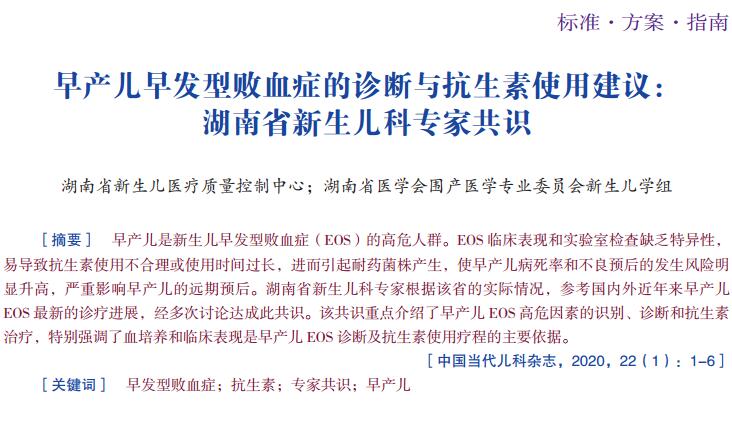 PDF(971 KB)
PDF(971 KB)


早产儿早发型败血症的诊断与抗生素使用建议:湖南省新生儿科专家共识
湖南省新生儿医疗质量控制中心;湖南省医学会围产医学专业委员会新生儿学组
中国当代儿科杂志 ›› 2020, Vol. 22 ›› Issue (1) : 1-6.
 PDF(971 KB)
PDF(971 KB)
 PDF(971 KB)
PDF(971 KB)
早产儿早发型败血症的诊断与抗生素使用建议:湖南省新生儿科专家共识
Recommendations on the diagnosis and the use of antibiotics for early-onset sepsis in preterm infant: consensus of the expert panel from Hunan Province
早产儿是新生儿早发型败血症(EOS)的高危人群。EOS临床表现和实验室检查缺乏特异性,易导致抗生素使用不合理或使用时间过长,进而引起耐药菌株产生,使早产儿病死率和不良预后的发生风险明显升高,严重影响早产儿的远期预后。湖南省新生儿科专家根据该省的实际情况,参考国内外近年来早产儿EOS最新的诊疗进展,经多次讨论达成此共识。该共识重点介绍了早产儿EOS高危因素的识别、诊断和抗生素治疗,特别强调了血培养和临床表现是早产儿EOS诊断及抗生素使用疗程的主要依据。
Preterm infants are at higher risk of developing early-onset sepsis (EOS). Due to non-specific clinical manifestations and lack of laboratory tests for prompt diagnosis of EOS, inappropriate use of antibiotics is common in preterm infants. Prolonged exposure to antibiotics can lead to antibiotic resistance and significantly increases the risk of mortality and morbidity. Based on the latest progress in the diagnosis and treatment for EOS, both in China and overseas, and considering the current condition in Hunan Province, the expert panel of neonatologists in Hunan have reached this consensus after many discussions. This consensus clarifies the risk factors, proposes the diagnostic criteria, and recommends the antibiotic use strategies for EOS in preterm infants. It is emphasized that blood culture results and clinical manifestations are the main basis for the diagnosis of EOS and the duration of antibiotics use in preterm infants.

Early-onset sepsis / Antibiotics / Expert consensus / Preterm infant
[1] Fleischmann-Struzek C, Goldfarb DM, Schlattmann P, et al. The global burden of paediatric and neonatal sepsis:a systematic review[J]. Lancet Respir Med, 2018, 6(3):223-230.
[2] Polin RA; Committee on Fetus and Newborn. Management of neonates with suspected or proven early-onset bacterial sepsis[J]. Pediatrics, 2012, 129(5):1006-10015.
[3] 吴仕孝. 新生儿败血症诊断标准修订方案[J]. 中华儿科杂志,1988, 26(3):163.
[4] 中华医学会儿科学分会新生儿学组, 中华医学会中华儿科杂志编辑委员会. 新生儿败血症诊疗方案(2003年昆明)[J]. 中华儿科杂志, 2003, 41(12):897-899.
[5] 中华医学会儿科学分会新生儿学组, 中国医师协会新生儿科医师分会感染专业委员会. 新生儿败血症诊断及治疗专家共识(2019年版)[J]. 中华儿科杂志, 2019, 57(4):252-257.
[6] Blanc WA. Pathways of fetal and early neonatal infection. Viral placentitis, bacterial and fungal chorioamnionitis[J]. J Pediatr, 1961, 59:473-496.
[7] Romero R, Dey SK, Fisher SJ. Preterm labor:one syndrome, many causes[J]. Science, 2014, 345(6198):760-765.
[8] Goldenberg RL, Hauth JC, Andrews WW. Intrauterine infection and preterm delivery[J]. N Engl J Med, 2000, 342(20):1500-1507.
[9] Carroll SG, Ville Y, Greenough A, et al. Preterm prelabour amniorrhexis:intrauterine infection and interval between membrane rupture and delivery[J]. Arch Dis Child Fetal Neonatal Ed, 1995, 72(1):F43-F46.
[10] Muglia LJ, Katz M. The enigma of spontaneous preterm birth[J]. N Engl J Med, 2010, 362(6):529-535.
[11] Cantey JB, Wozniak PS, Sánchez PJ. Prospective surveillance of antibiotic use in the neonatal intensive care unit:results from the SCOUT study[J]. Pediatr Infect Dis J, 2015, 34(3):267-272.
[12] Ting JY, Synnes A, Roberts A, et al. Association between antibiotic use and neonatal mortality and morbidities in very low-birth-weight infants without culture-proven sepsis or necrotizing enterocolitis[J]. JAMA Pediatr, 2016, 170(12):1181-1187.
[13] Zhu M, Jin Y, Duan Y, et al. Multi-drug resistant Escherichia coli causing early-onset neonatal sepsis-a single center experience from China[J]. Infect Drug Resist, 2019, 12:3695-3702.
[14] Vinturache AE, Gyamfi-Bannerman C, Hwang J, et al. Maternal microbiome-a pathway to preterm birth[J]. Semin Fetal Neonatal Med, 2016, 21(2):94-99.
[15] Puopolo KM, Mukhopadhyay S, Hansen NI, et al. Identification of extremely premature infants at low risk for early-onset sepsis[J]. Pediatrics, 2017, 140(5). pii:e20170925.
[16] Dunne WM Jr, Case LK, Isgriggs L, et al. In-house validation of the BACTEC 9240 blood culture system for detection of bacterial contamination in platelet concentrates[J]. Transfusion, 2005, 45(7):1138-1142.
[17] Nanua S, Weber C, Isgriggs L, et al. Performance evaluation of the VersaTREK blood culture system for quality control testing of platelet units[J]. J Clin Microbiol, 2009, 47(3):817-818.
[18] Wynn JL, Wong HR, Shanley TP, et al. Time for a neonatal-specific consensus definition for sepsis[J]. Pediatr Crit Care Med, 2014, 15(6):523-528.
[19] Sarkar SS, Bhagat I, Bhatt-Mehta V, et al. Does maternal intrapartum antibiotic treatment prolong the incubation time required for blood cultures to become positive for infants with early-onset sepsis?[J]. Am J Perinatol, 2015, 32(4):357-362.
[20] Yaacobi N, Bar-Meir M, Shchors I, et al. A prospective controlled trial of the optimal volume for neonatal blood cultures[J]. Pediatr Infect Dis J, 2015, 34(4):351-354.
[21] Puopolo KM, Benitz WE, Zaoutis TE, et al. Management of neonates born at ≤ 346/7 weeks' gestation with suspected or proven early-onset bacterial sepsis[J]. Pediatrics, 2018, 142(6). pii:e20182896.
[22] Schrag SJ, Farley MM, Petit S, et al. Epidemiology of invasive early-onset neonatal sepsis, 2005 to 2014[J]. Pediatrics, 2016, 138(6). pii:e20162013.
[23] Puopolo KM, Draper D, Wi S, et al. Estimating the probability of neonatal early-onset infection on the basis of maternal risk factors[J]. Pediatrics, 2011, 128(5):e1155-e1163.
[24] 全国细菌耐药监测网. 2014至2017年中国儿童及新生儿患者细菌耐药监测研究[J]. 中华医学杂志, 2018, 98(40):3279-3287.
[25] 唐韵, 潘丽萍, 章蓓蕾. 产超广谱β-内酰胺酶菌的耐药性与基因型分析[J]. 中华医院感染学杂志, 2012, 22(18):3938-3941.
[26] 刘艳, 马丹娟, 黄瑞玉, 等. 新生儿重症监护病房多重耐药革兰阴性菌血流感染危险因素回归分析[J]. 检验医学与临床, 2019, 16(6):783-785.
[27] Cantey JB, Baird SD. Ending the culture of culture-negative sepsis in the neonatal ICU[J]. Pediatrics, 2017, 140(4). pii:e20170044.